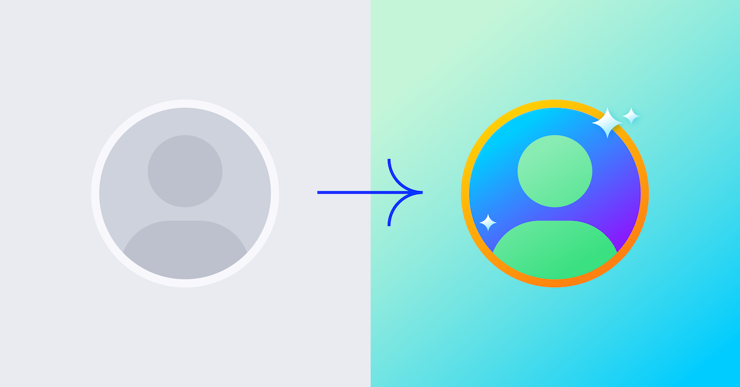Wie fange ich mit der Personalisierung an? Drei einfache Strategien für sofortige Wirkung


Es ist kein Geheimnis, dass Personalisierung wichtiger ist als je zuvor. Laut einem Bericht von McKinsey & Company aus dem Jahr 2021 erwarten 71% der Verbraucher, dass Unternehmen personalisierte Interaktionen anbieten. Und 76% sind frustriert, wenn dies nicht der Fall ist.

Die Planung Ihrer Personalisierungsstrategie kann sich überwältigend anfühlen, wenn Sie bei Null anfangen (oder auch wenn Sie es nicht tun).
Keine Sorge, wir haben alles für Sie! Im Folgenden geben wir Ihnen einige einfache Tipps für den Aufbau und die Umsetzung einer Personalisierungsstrategie, mit der Sie das Engagement und die Conversion Ihrer Kunden steigern und sie begeistern können.
Verstehen Sie die Grundlagen: Was ist Personalisierung?
Lassen Sie uns zunächst sicherstellen, dass wir mit den Grundlagen auf derselben Seite stehen. Personalisierung bedeutet, Marketingmaßnahmen auf einzelne Kunden zuzuschneiden, und zwar auf der Grundlage ihrer Vorlieben, ihres Verhaltens und ihrer Daten. Es geht darum, die richtige Botschaft zum richtigen Zeitpunkt zu übermitteln.
Vollständiger Überblick: Was ist Personalisierung?
Warum ist Personalisierung so wichtig?
Personalisierung:
- Verbessert das Erlebnis des Kunden
- Erhöht das Engagement und die Conversion Rates
- Verbessert die Kundenbindung und -loyalität
- Ermöglicht einen effizienteren Einsatz von Marketing Personas
Erste Schritte zur Personalisierung
Wenn Marken mit der Personalisierung beginnen, wissen sie oft nicht, wen sie mit welchen Erlebnissen ansprechen sollen. Diese Erfolgsmethoden können Ihnen helfen, die Überforderung zu bekämpfen und den richtigen Weg einzuschlagen:

#1 - Beginnen Sie mit Ihren Personas
Hat Ihr Unternehmen ein klares Profil des idealen Kunden (ICP) erstellt oder Personas als Zielkunden identifiziert? Wenn ja, dann beginnen Sie damit, Personalisierungskampagnen für diese Personas zu konzipieren. Damit stellen Sie sicher, dass Ihre Strategien auf einem soliden Verständnis Ihrer Zielgruppe beruhen. Haben Sie noch keine Targeting Personas oder müssen Sie diese auffrischen? Hubspot bietet eine Schritt-für-Schritt-Anleitung und kostenlose Vorlagen, die Sie bei diesem Prozess unterstützen.
#Nr. 2 - Targeting Ihrer breitesten Zielgruppen
Eine weitere Möglichkeit besteht darin, mit den breitesten Zielgruppensegmenten zu beginnen, z. B:
- Interessenten vs. Kunden
- Erstkäufer vs. Wiederholungskäufer
- Desktop vs. Mobile
Wenn Sie mehr Daten und Erkenntnisse sammeln, können Sie Ihren Ansatz verfeinern und detailliertere Strategien zur Personalisierung entwickeln.
#Nr. 3 - Priorisieren Sie relevante Erlebnisse für Ihre Kunden
Konzentrieren Sie sich auf die Bereitstellung von personalisierten Erlebnissen, die für Ihre Kunden wirklich wichtig sind. Laut McKinsey (erneut) erwarten 68 % der Verbraucher relevante Produkt-/Dienstleistungsempfehlungen. Berücksichtigen Sie also Verhaltensdaten und suchen Sie nach Möglichkeiten, Empfehlungen auf der Grundlage von Interesse/Absicht zu geben.
Beispiele für Personalisierung
Sehen wir uns einige Beispiele für Personalisierung in den Bereichen Einzelhandel, Banken und Reisen an.
Personalisierung im Einzelhandel: Browser in Käufer verwandeln
In der wettbewerbsintensiven Welt des Einzelhandels kann Personalisierung der Schlüssel zur Differenzierung und zur Steigerung der Conversion sein. Hier finden Sie drei wirkungsvolle Strategien, um das Erlebnis Ihrer Kunden zu personalisieren:
#1 - Behavioral Targeting: Behavioral Targeting zeigt Besuchern ein personalisiertes Erlebnis auf der Grundlage ihres Echtzeit-Verhaltens und ihrer Interaktionen mit Ihrer Site.
Test + Learn: Experimentation
Es gibt unzählige Möglichkeiten, Behavioral Targeting anzuwenden. So können Marken beispielsweise mit Behavioral Targeting Kunden, die in den letzten 30 Tagen Handtaschen im Wert von mehr als 400 $ gekauft haben, mit Sonderangeboten für ausgewählte Produkte ansprechen, um ihren Handtaschenkauf zu ergänzen.
#Nr. 2 - Symmetrisches Messaging. Wenn Sie symmetrisches Messaging verwenden, setzen Sie in Anzeigen- und E-Mail-Kampagnen Erwartungen, die mit den Erlebnissen auf der Website übereinstimmen. Wenn Besucher von einer auf einer Suchmaschine, einem sozialen Netzwerk oder einer Website eines Drittanbieters gehosteten Anzeige auf Ihre Seite klicken, stimmen CTA, Botschaften und Bilder, die sie auf Ihrer Site sehen, mit dem Erlebnis in der Anzeige überein.
Beispiel: Ein Unternehmen für Sportbekleidung schickt seinen Kunden eine E-Mail mit einer Rabattaktion für zwei Tage auf Yoga-Kleidung. Wenn ein Kunde, der die Werbeaktion erhalten hat, Ihre Website besucht, sieht er in der Kopfzeile der Homepage Yoga-Produkte und ein Banner mit dem Rabattcode.
#Nr. 3 - Kategorie-Affinität. Sie können das frühere Surfverhalten Ihrer Besucher nutzen, um deren Vorlieben zu verstehen und ihnen später oder bei zukünftigen Besuchen bevorzugte Produktkategorien anzuzeigen. (Tipp: Sie können dies in Optimizely tun, indem Sie bestehende Ereignisse für das Targeting auf der Grundlage bestehender Seitenaufrufe und mehr verwenden).
Beispiel: Ein Kunde besucht eine bestimmte Produktseite zweimal in einer Woche, und wenn er auf die Startseite zurückkehrt, sieht er Bilder, einen CTA oder Angebote, die sich ausschließlich auf das Produkt beziehen.
Personalisierung von Bank- und Finanzdienstleistungen
In der Welt des Bankwesens tragen maßgeschneiderte Empfehlungen und Angebote dazu bei, noch mehr Wert zu schaffen und den Finanzinstituten zu helfen, Vertrauen und Loyalität bei ihren Kunden aufzubauen.
#1 - Personalisierte Sparziele. Bieten Sie personalisierte Sparziele und Empfehlungen an, die auf Ihrer finanziellen Situation und Ihren Ausgabengewohnheiten basieren. Die Mobile App einer Bank kann zum Beispiel die Transaktionshistorie eines Kunden analysieren und personalisierte Sparziele für Meilensteine wie Urlaub, Hauskauf oder Notfallfonds vorschlagen.
#Nr. 2 - Individuelle Angebote für Empfehlungsprogramme. Bieten Sie einem geworbenen Kunden und dem geworbenen Kunden maßgeschneiderte Anreize, wenn sie eine bestimmte Aktion durchführen, z. B. eine qualifizierte Einzahlung vornehmen, ein Konto eröffnen oder eine Kreditkarte beantragen.
#Nr. 3 - Dynamische Kreditangebote. Testen Sie verschiedene Kreditangebote und Konditionen, um die Conversion Rates auf der Grundlage der Kreditwürdigkeit, des Einkommens und der finanziellen Ziele eines Kunden zu optimieren. Sie können mit Optionen wie niedrigeren Zinssätzen, längeren Rückzahlungsfristen usw. experimentieren.
Personalisierung von Reisen
Fluggesellschaften, Hotels und Ferienanlagen können das Buchungserlebnis optimieren und personalisierte Empfehlungen geben, um den Umsatz zu steigern.
#1 - Maßgeschneiderte Buchungsempfehlungen. Analysieren Sie den bisherigen Buchungsverlauf, die Vorlieben und das Surfverhalten, um Buchungsempfehlungen zu personalisieren. Beispiel: Einem Passagier, der häufig in tropische Gegenden reist, können Fluggesellschaften Flugangebote zu beliebten Strandzielen unterbreiten.
#Nr. 2 - Dynamische Preisgestaltung und Verpackung. Führen Sie A/B-Tests durch, um die effektivsten Preisstrategien für verschiedene Kundensegmente zu ermitteln (ermäßigte Tarife, Pakete, Freischaltung von Treueprämien). Testen Sie verschiedene Preis- und Paketangebote (z.B. Flitterwochen, Aufenthalte in der Wochenmitte, 3 Nächte kaufen und die 4. gratis erhalten, Resort-Gutschriften oder Erlebnisse eingeschlossen usw.), um den Umsatz und die Auslastung zu maximieren. Berücksichtigen Sie Buchungsvorlaufzeiten, Nachfragetrends und Gästepräferenzen.
#Nr. 3 - Buchungserlebnis. Testen Sie verschiedene Versionen des Buchungsprozesses (z.B. Website- und App-Layouts, CTAs oder Preisgestaltung), um die Conversion Rates auf der Grundlage von Treuestatus/Vielfliegern oder Buchungshistorie und -präferenzen zu optimieren.
Wie Sie die wichtigsten Herausforderungen der Personalisierung meistern
- Datenerfassung und -verwaltung: Implementieren Sie eine solide Datenerfassung und -verwaltung, um sicherzustellen, dass Sie über genaue, aktuelle Informationen verfügen, die Sie bei Ihren Personalisierungsbemühungen unterstützen.
- Bringen Sie Personalisierung und Datenschutz in Einklang: Seien Sie transparent in Bezug auf Ihre Richtlinien zur Datenerfassung und -verwendung und stellen Sie den Datenschutz Ihrer Kunden immer in den Vordergrund. Bieten Sie klare Opt-Out-Richtlinien an und halten Sie sich an die einschlägigen Datenschutzbestimmungen.
- Vermeiden Sie eine übermäßige Personalisierung: Sorgen Sie für ein gesundes Gleichgewicht zwischen übermäßiger Personalisierung und Benutzerkomfort. Vermeiden Sie es, übermäßig aufdringlich zu sein oder den Kunden das Gefühl zu geben, sich unwohl zu fühlen.
- A/B-Testing und Personalisierung: Testen und optimieren Sie Ihre Personalisierungsstrategien kontinuierlich durch A/B-Testing und Experimentieren. So können Sie herausfinden, was für Ihr Publikum am besten funktioniert und die Wirkung Ihrer Bemühungen maximieren.
Fazit
Der Einstieg in die Personalisierung kann überwältigend erscheinen, aber er ist ein entscheidender Schritt, um die Erwartungen moderner Verbraucher zu erfüllen und das digitale Wachstum voranzutreiben. Wenn Sie die in diesem Artikel beschriebenen einfachen Schritte befolgen - beginnend mit Personas, Targeting für breite Zielgruppen und Priorisierung relevanter Erlebnisse - können Sie eine solide Grundlage für Ihre Personalisierung schaffen.
Denken Sie daran, dass Personalisierung ein fortlaufender Prozess des Lernens und der Optimierung ist. Beginnen Sie mit den Grundlagen, verfolgen Sie Ihre Ergebnisse und verfeinern Sie Ihren Ansatz kontinuierlich auf der Grundlage von Daten und Kundenfeedback. Wenn Sie diese Strategien an verschiedenen Berührungspunkten und in verschiedenen Branchen umsetzen, werden Sie nicht nur die Frage "Wie fange ich mit der Personalisierung an?" beantworten, sondern auch neue Möglichkeiten für Engagement, Conversion und Kundentreue erschließen.
Mit den richtigen Tools, Strategien und der richtigen Einstellung können Sie ein Personalisierungsprogramm erstellen, das aussagekräftige Ergebnisse liefert und Ihre Marke von der Konkurrenz abhebt.
Sind Sie bereit, mehr zu erfahren? Diese Ressourcen helfen Ihnen, den nächsten Schritt zu tun:

